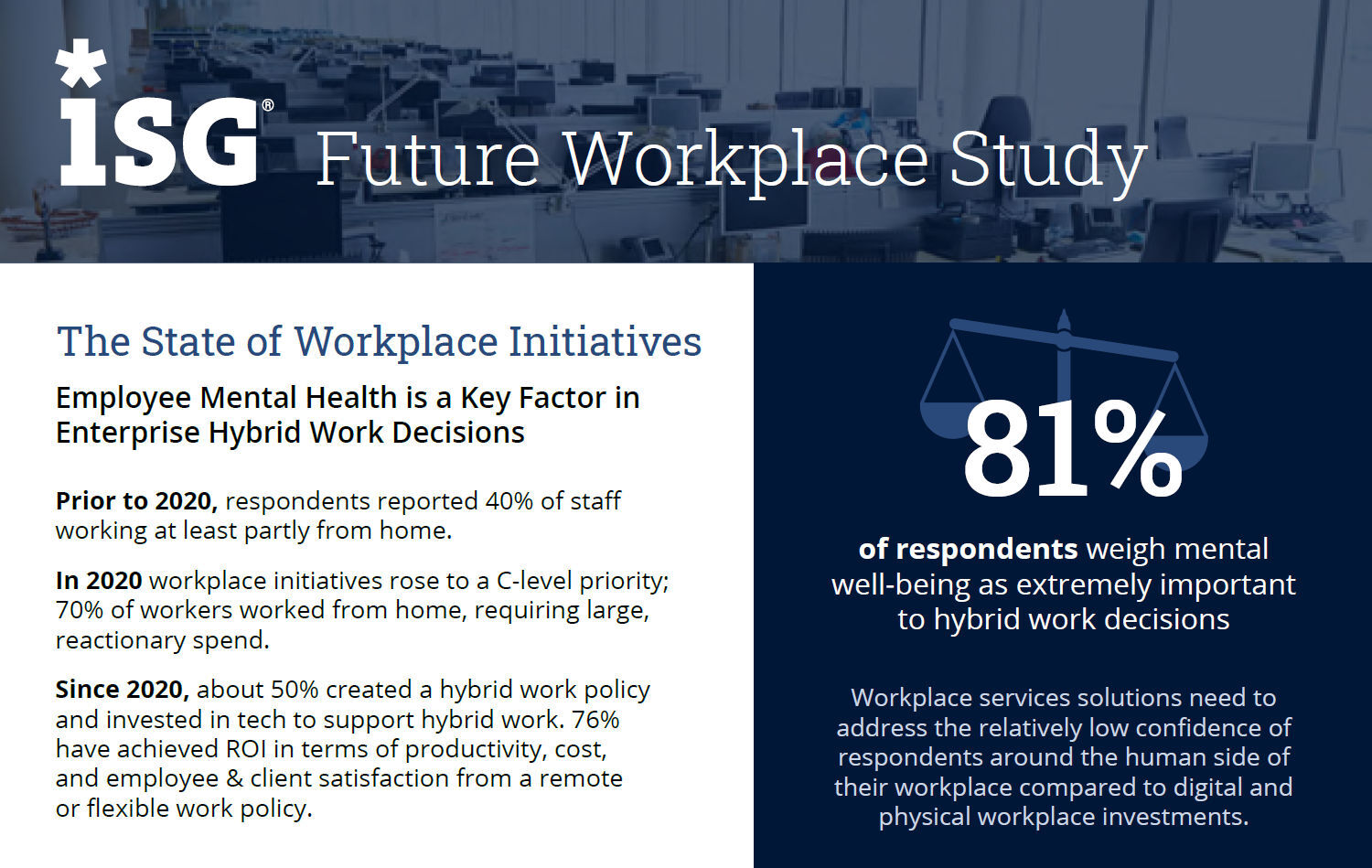The Secret to Elevating the Hybrid Work Employee Experience
Discover how to elevate the hybrid work employee experience by transforming traditional onboarding into meaningful interactions.



COVID-19 forced new ways of working, whether we were ready or not. As workers head back to the office, the workplace must adapt. Smart facilities, connected employees, AI and augmented capabilities will drive a healthier and "lower touch" office. The workforce of the future will be highly digital -- gig workers, remote collaborative workers, office-based workers -- all need to connect to customers and to each other. Capacity planning and management are key factors.

ISG's recent study shows employee mental health is a key factor in enterprise hybrid work decisions.
Learn how to adapt to constantly changing business conditions through operational resilience and agility.
Discover how to take today’s challenges as opportunities to provide a better workplace experience backed by innovative technologies.

ISG is a leader in proprietary research, advisory consulting and executive event services focused on market trends and disruptive technologies.
Get the insight and guidance you need to accelerate growth and create more value.
Learn MoreOur 2025 research divides the workforce-management landscape into five focused guides—WFM Basics, WFM Suites, WFM for Healthcare, WFM for Manufacturing and WFM for Retail. Each report applies a common evaluation lens yet weights criteria to reflect the operational realities, compliance pressures and innovation priorities unique to its scope. Together, they provide a panoramic view of the market and a set of targeted benchmarks that let buyers zero in on the capabilities—and partners—best aligned to their context.
Although the COVID-19 pandemic years are becoming distant memories, the changes it brought to how we work remain. Many global organizations tried, in vain, to reinstate the old ways of working with their Return-to-Office (RTO) policies. These policies face stiff resistance from the workforce, who have experienced the pros and cons of working remotely and understand that they can deliver quality output without physically being in the office. End-user technology, encompassing all the devices, applications and tools needed for work irrespective of location, has become a key driver in ensuring a successful hybrid work strategy. Ensuring an uninterrupted end-user technology experience is at the forefront of the list of priorities of enterprise IT teams. The enterprise IT teams should ensure that the devices and applications that employees use while working in a remote or hybrid environment are always up and running. There should be an automated resolution of issues associated with the end-user technology IT assets. If any issue requires reaching out to enterprise IT, it should be resolved immediately.
When we analyzed the Future of Work Services market last year, we defined 2023 as the year of stabilization. While the 2 – 3 years of the COVID-19 pandemic are increasingly becoming a distant memory, the changes it brought in
the way people work persist and are redefining how organizations frame their new future of work strategy. Enterprises started adopting return-to-office (RTO) policies last year, a move that, according to multiple studies, employees did not receive well. Organizations are implementing hybrid ways of work policies, allowing their workforce the flexibility to work from a location of their choice but mandating in some instances where in-office presence is essential. These policies profoundly guide how enterprise workplace leaders define the technology and operational approach with their workforce.
Digital workplaces: Transforming the future of U.S. public services
State and local government and educational (SLED) institutions are undergoing a significant transformation. They are rapidly transitioning to digital workplaces that are more manageable, efficient and equipped to handle the demands of a technology-driven society.
By the late 2020s, Gen Alpha will move into the workforce, introducing a new dynamic. With the potential for up to five or six generations in the workplace, enterprises are often challenged to understand how to bridge the generation gap and create a cohesive workforce. The answer can be found within your technology stack.
Companies with cloud-based contact centers quickly implemented a work-from-home setup with minimal disruption when the pandemic hit. The benefits of remote work have been on display ever since. The ISG Provider Lens™ Contact Center as a Service Global 2020 report explores how accelerating your contact center’s move to cloud can bring with it new personalization and workforce management capabilities.
Organizations must continue to adapt using automation, collaboration tools and optimal office environments to ensure they can make the most of their greatest asset – their people.

